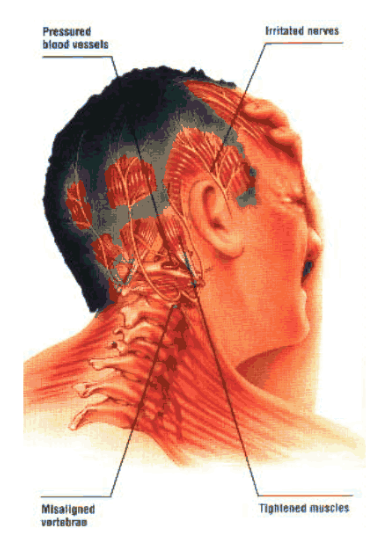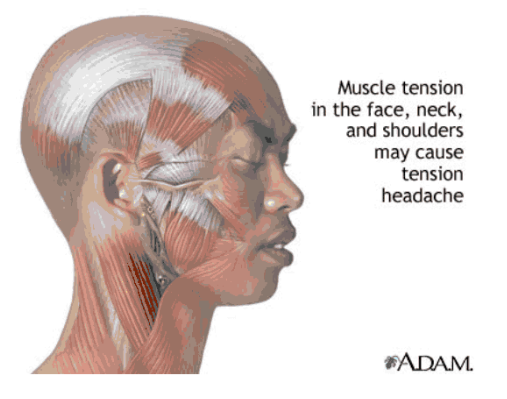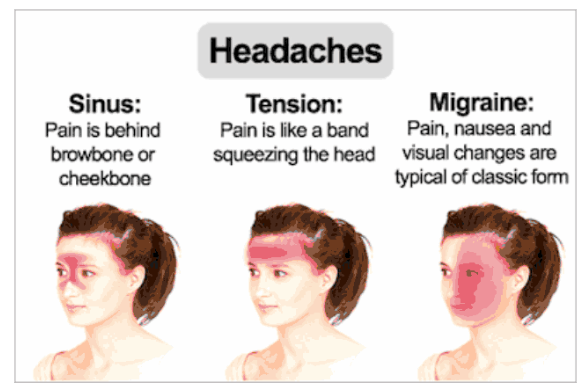A tension headache is pain or discomfort in the head, scalp, or neck, usually associated with muscle tightness in these areas.

Causes, incidence, and risk factors
Tension headaches are one of the most common forms of headaches. They may occur at any age, but are most common in adults and adolescents.
If a headache occurs two or more times a week for several months or longer, the condition is considered chronic. Chronic daily headaches can result from the under- or over-treatment of a primary headache.
Rebound headaches are headaches that keep coming back. They may occur if you overuse painkillers.
Tension headaches occur when neck and scalp muscles become tense, or contract. The muscle contractions can be a response to stress, depression, a head injury, or anxiety.
Any activity that causes the head to be held in one position for a long time without moving can cause a headache. Such activities include typing or other computer work, fine work with the hands, and using a microscope. Sleeping in a cold room or sleeping with the neck in an abnormal position may also trigger a tension headache.
Other triggers of tension headaches include:
Alcohol use
Caffeine (too much or withdrawal)
Colds, the flu, or a sinus infection
Dental problems such as jaw clenching or teeth grinding
Eye strain
Excessive smoking
Fatigue or overexertion
Tension headaches can occur when you also have a migraine. Tension headaches are not associated with brain diseases.

Symptoms
The headache pain may be described as:
Dull, pressure-like (not throbbing)
A tight band or vise on the head
All over (not just in one point or one side)
Worse in the scalp, temples, or back of the neck, and possibly in the shoulders
The pain may occur as an isolated event, constantly, or daily. Pain may last for 30 minutes to 7 days. It may be triggered by or get worse with stress, fatigue, noise, or glare.
There may be difficulty sleeping. Tension headaches usually do not cause nausea or vomiting.
People with tension headaches tend to try to relieve pain by massaging their scalp, temples, or the bottom of the neck.
Signs and tests
A headache that is mild to moderate, not accompanied by other symptoms, and responds to home treatment within a few hours may not need further examination or testing, especially if it has occurred in the past. A tension headache reveals no abnormal findings on a neurological exam. However, tender points (trigger points) in the muscles are often seen in the neck and shoulder areas.
The health care provider should be consulted—to rule out other disorders that can cause headache—if the headache is severe, persistent (does not go away), or if other symptoms are present with the headache.
Headaches that disturb sleep occur whenever you are active, or that are recurrent or chronic may require examination and treatment by a health care provider.

Treatment
Jalaneti (every morning before breakfast)
Vajrasana + ujjaji breath (5mins)
Asanas starting with 30 seconds, gradually build up to 60 seconds.
Everyday 30 mins of asanas before breakfast (if not possible, then before dinner)
WEEK1
(repeat twice)
- Joint movements
- Tiger breathing + shanshankasana
- Bhujangasana breathing + shashankasana
- Paryankasana
- Ardha Ushtrasana
- Leg Raising
- Ardha Matsyasana
- Savasana
Palming, washing face with water
Kapalabhati
WEEK 2
(repeat twice)
- Joint movements
- Tadasana
- Vrikshasana
- Prasarita Padottanasana (head and neck relaxed)
- Tiger breathing + shanshankasana
- Bhujangasana breathing + shashankasana
- Paryankasana
- Ardha ushtrasana
- Leg Raising
- Ardha Matsyasana
- Savasana
Palming, washing face with water
Shanmukti Mudra
WEEK 3
- Classical Surya Namaskar (3 rounds)
- Tadasana
- Vrikshasana
- Ardha Chakrasana variation (hands on lower back)
- Parshvottanasana variation (hands on floor)
- Prasarita Padottanasana (neck + head relaxed)
- Paschimottanasana (neck relaxed)
- Purvottanasana (neck relaxed)
- Tiger breathing + shanshankasana
- Bhujangasana breathing + shashankasana
- Paryankasana
- Ushtrasana
- Sethu Bandasana (or Chakrasana if more flexible)
- Ardha Matsyasana
- Savasana (15 mins)
Palming, washing with water
Nadi Shodi
Every evening before sleep 5 mins Vajrasana, observing natural breath and body sensations.
Observe natural breathing whenever possible.




